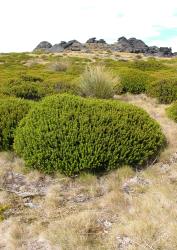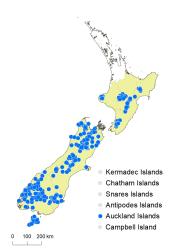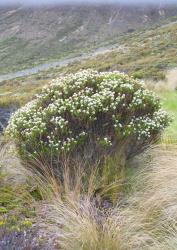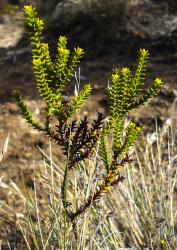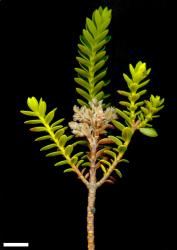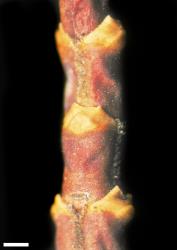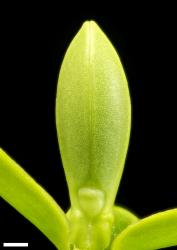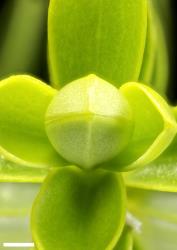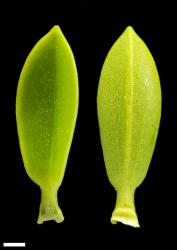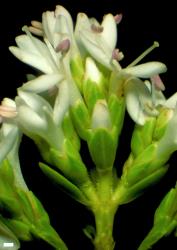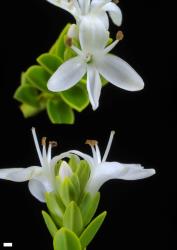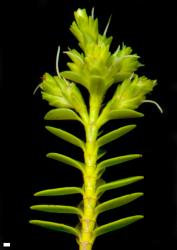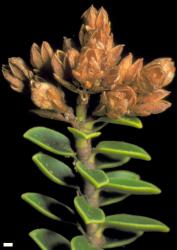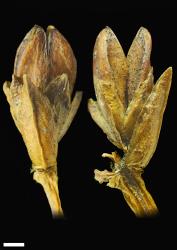- Taxon
- Gallery
- ≡ Veronica buxifolia var. odora (Hook.f.) Kirk, Trans. New Zealand Inst. 28: 523 (1896)
- ≡ Veronica elliptica var. odora (Hook.f.) Cheeseman, Man. New Zealand Fl. 516 (1906)
- ≡ Hebe buxifolia var. odora (Hook.f.) Andersen, Trans. New Zealand Inst. 56: 693 (1926)
- ≡ Hebe odora (Hook.f.) Cockayne, Trans. New Zealand Inst. 60: 472 (1929)
- ≡ Leonohebe odora (Hook.f.) Heads, Bot. Soc. Otago Newsl. 5: 10 (1987)
- = Veronica buxifolia Benth. in de Candolle, Prodr. 10 462 (1846)
- ≡ Hebe buxifolia (Benth.) Andersen, Trans. New Zealand Inst. 56: 693 (1926)
- = Veronica anomala Armstr., Trans. New Zealand Inst. 4: 291 (1872)
- ≡ Hebe anomala (Armstr.) Cockayne, Trans. New Zealand Inst. 60: 468 (1929)
- = Veronica haustrata J.B.Armstr., N.Z. Ctry. J. 3: 58 (1879)
- ≡ Hebe haustrata (J.B.Armstr.) Andersen, Trans. New Zealand Inst. 56: 693 (1926)
- = Veronica buxifolia var. patens Cheeseman, Man. New Zealand Fl. 523 (1906)
- = Veronica buxifolia var. prostrata Cockayne, Rep. Bot. Surv. Stewart Island 44 (1909)
- ≡ Hebe buxifolia var. prostrata (Cockayne) Andersen, Trans. New Zealand Inst. 56: 693 (1926)
Usually rounded (sometimes mat-forming) shrub to 1.7 m tall, usually shorter. Stems usually ascending to erect, rarely prostrate to decumbent, eglandular-pubescent; hairs bifarious. Leaf bud distinct, its leaves appressed at margins until fully grown; sinus broad and shield-shaped. Leaves opposite-decussate, erect to spreading; lamina coriaceous, rigid, lanceolate, ovate, elliptic, obovate, oblanceolate, or sub-orbicular, 3.6–11.5 mm long, 2.3–5.4 mm wide, glossy green above, dull green beneath; midrib and sometimes 2 lateral veins evident; surfaces glabrous; margin glabrous, entire or rarely minutely crenulate; apex sub-acute to apiculate; base truncate; petiole 0.5–2.2 mm long. Inflorescence terminal and usually also lateral, spicate, 0.6–2.8 mm long; flowers crowded, 4–12, all bisexual, or female and bisexual on separate plants in some populations, ⚥ > ♀; bracts opposite-decussate and free, ovate; pedicels absent. Calyx lobes 4, sub-acute to obtuse, sub-equal, 3.0–4.5 mm long, ciliolate. Corolla 10–13 mm diameter; tube white, 3.0–3.5 mm long, ≥ calyx, eglandular-hairy inside; lobes 4, white or rarely pinkish, spreading to recurved, sub-equal, narrowly elliptic, 5–6 mm long, obtuse; nectar guides absent. Stamen filaments white, 2.0–3.2 mm long; anthers pink. Style glabrous, 5.5–7.0 mm long. Capsules latiseptate, sub-acute or obtuse, glabrous, 3.9–4.5 mm long, 3.4–3.6 mm at widest point. Seeds ellipsoid to discoid, flattened, smooth, straw-yellow to pale brown, 1.2–1.8 mm long.
V. odora is distinctive but superficially easy to confuse with several other hebes. The leaves have many dense stomata, visible as pale dots, on the abaxial and rarely also (e.g., at Arthur’s Pass) the adaxial surface. The margins are bevelled. The flowering stem is terminated by an inflorescence, and lateral inflorescences occur below it to give the appearance of a compound raceme. However, such lateral spikes are subtended by normal leaves (shouldered at the base to a short petiole, glabrous), whereas the flowers are subtended by opposite leaf-like bracts that differ from leaves by being deltoid, sessile, and ciliolate. The flowers are sessile with narrowly elliptic corolla lobes.
Most commonly plants of V. odora are mistaken for V. venustula or V. brachysiphon, which are superficially similar in their leaf size and densely rounded shrub habit. V. brachysiphon and V. venustula plants differ from V. odora in their narrower and acute sinus, cuneate leaf bases, and particularly in the always lateral inflorescences of at least shortly pedicellate flowers, small bracts, and broader corolla lobes.
Plants of three other species have broad, shield-shaped sinuses and leaf bases that narrow abruptly to the petiole. Of these, plants of V. mooreae and V. pauciramosa can be distinguished from V. odora plants by their lateral inflorescences, and often their anterior calyx lobes are fused in the basal portion or up to ⅔ of the way. V. masoniae plants also have terminal inflorescences and free anterior calyx lobes, but they differ in having conspicuous stomata on both leaf surfaces (however, note these are also present in V. odora at Arthur’s Pass), rounded leaf margin (bevelled in V. odora), and broad corolla lobes. Flowers of V. masoniae and V. pauciramosa have red stigmas.
(See: Morphological features to distinguish Veronica odora and look-alikes. Species are ordered according to similarity of their habit.)
| odora | mooreae | pauciramosa | masoniae | venustula | brachysiphon |
|---|---|---|---|---|---|---|
Leaf bud sinus | broad, shield-shaped | narrow & acute to broad & shield shaped | broad, shield-shaped | broad, shield-shaped | narrow, acute | narrow, acute |
Leaf margin | sharply bevelled; glabrous | bevelled at 90º to surfaces, glabrous | rounded; glabrous or with minute hairs or denticles | rounded, papillate towards apex; ciliolate when young | weakly bevelled; ciliolate when young, becoming glabrous or papillate | weakly bevelled; ciliolate to ciliate when young, becoming papillate |
Stomata | adaxial – (but often + at Arthur’s Pass); abaxial + | adaxial – (+ at Caswell Sound, Denniston); abaxial + | adaxial +; abaxial + | adaxial +; abaxial + | adaxial ±; abaxial + | adaxial ±; abaxial + |
Midrib | sharply keeled beneath | depressed above; prominent beneath | rounded beneath and flattened just short of apex | keeled throughout | evident but not keeled | evident but not keeled |
Inflorescence | terminal + usually lateral spikes | lateral spikes only | lateral spikes only | terminal spikes only | lateral raceme, sometimes ternate, rarely compound. | lateral raceme, sometimes ternate. |
Bracts | not overtopping calyx | < calyx | < calyx | ≥ calyx | ≥ pedicels, < calyx | ≥ pedicels, < calyx |
Bracts and flowers | opposite | opposite | opposite | opposite | opposite below, becoming alternate | alternate, or lowermost opposite |
Pedicels | 0 mm | 0–1 mm | 0–0.5 mm | 0 mm | 0.5–7.0 mm | 0.6–3.0 mm |
Calyx, anterior lobes | free | free or fused to ⅓-way | fused > ⅔-way | free | free | free |
Corolla lobes | narrow | broad | narrow | broad | ± broad | ± broad |
North Island: Gisborne (Huiarau Range southwards), Volcanic Plateau (south of Lake Taupō), Taranaki (Taranaki National Park and Ruahine Range), southern North Island.
South Island: throughout.
Stewart I., Auckland Is.
Montane to penalpine grassland and scrub, often in damp to wet sites, extending to low altitudes in the south. Recorded elevations range from 0 to 1672 m.
V. odora commonly hybridises with whipcord hebes throughout its range (e.g., V. odora × tetragona in the North Island, V. hectorii × odora in the South Island, and perhaps other combinations as well). Such hybrids are cultivated under various names, especially V. ×cassinioides and V. ‘Christensenii’. V. armstrongii × odora has been given the cv name hebe ‘Karo Golden Esk’.
Flowering: November–January (sometimes to March); fruits: December–April, sometimes persisting until November.
2n = 42 in North Island, South Island north of about Hanmer Springs, Auckland Is.; 2n = 84, South Island from about Hanmer Springs southwards, Stewart I. (see Bayly & Kellow 2006, as Hebe odora).
Veronica odora is classified in V. subg. Pseudoveronica sect. Hebe and the informal group “Buxifoliatae” (Albach & Meudt 2010; Bayly & Kellow 2006).
V. odora consistently emerges as sister species to V. pauciramosa in phylogenetic trees (e.g., Wagstaff et al. 2002). This sister species pair is sister to a cluster of V. epacridea and V. kellowiae (Wagstaff et al. 2002), and also V. haastii and V. macrocalyx (E.M. Low, unpublished), which all have similar inflorescences.
Cultivars
The cultivar hebe ‘Anomala’ has reddish stems, narrow, red-tinged leaves, and flowers that usually have only three corolla lobes. It is probably not the same as Veronica anomala Armstr.



